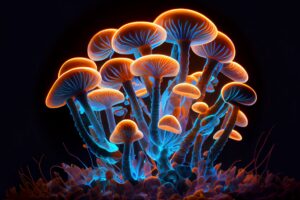In pockets around the globe, people are becoming more attuned to the therapeutic benefits of psychedelic drugs: The Federal Drug Administration (FDA) recently approved a form of ketamine for depression; the world’s first center for psychedelic research opened last month in London; and in big cities, young professionals say microdosing psilocybin and LSD helps them stay on top of their game.
One of the contributors to this shift in consciousness is MAPS, the Multidisciplinary Association for Psychedelic Studies. Since 1986, MAPS has helped fund and organize research on the medicinal uses of psychedelics and cannabis.
FOLLOW US ON FACEBOOK & INSTAGRAM
MAPS’ most publicized work to date involves the use of MDMA (3,4methylenedioxymethamphetamine) during psychotherapy sessions for veterans and other folks with PTSD. The results were so successful that the FDA is now working with MAPS on the next phase of research on MDMA. If all goes well, we could see MDMA-assisted psychotherapy become available to the public by 2021.
To better understand what the future has in store for MAPS, MDMA-assisted psychotherapy and psychedelics as a whole, we sat down with Rick Doblin, the organization’s founder and executive director.
Q: Why did MAPS choose to focus on MDMA-assisted psychotherapy as opposed to the other psychedelics?
The goal for me was mainstreaming psychedelic medicine. And the reason that MDMA was chosen is that it’s the most gentle of all of the psychedelics.
The classic psychedelics act by dissolving our filtering systems—more or less the system in our brain talking about the ego. LSD and psilocybin weaken that part of the brain. You don’t see things from your own individual perspective anymore, but you see a larger perspective, and you get more sensory input.
When your sense of identity is dissolving, sometimes it feels like you’re physically dying, or people just get really, really scared. That aspect of losing control, of letting the ego go—that’s challenging to people. But MDMA doesn’t do that. MDMA strengthens your sense of who you are.
Q: And out of all of the conditions that MDMA can help with, why did you choose to focus on PTSD?
We needed a highly sympathetic patient population. And in general, we also wanted a condition that at the time wasn’t currently understood to be biologically caused.
PTSD is something that happens during your life. It’s based on a biographical series of events. And so it’s more likely psychotherapy, rather than pharmacotherapy, would help. But also, if you were to try to develop a drug for PTSD, MDMA would be it.
MDMA reduces activity in the amygdala; it increases activity in the prefrontal cortex, so you can think more logically. It increases activity between the amygdala and the hippocampus to permit memories to move out of short-term to long-term storage.
The problem with PTSD is these traumatic memories make it seem like they’re always about to happen or they’re always happening.
Plus, [MDMA] stimulates oxytocin and prolactin, which are the hormones of nurturing, bonding and love, so it helps build a certain amount of trust between the patients and the therapist. All of [these chemical cascades] make it so that MDMA permits people to look at challenging emotions without so much fear.
We needed a condition for which the currently available medicines or psychotherapies left a large number of treatment-resistant people—and that’s PTSD. There are roughly a million veterans receiving disability for PTSD.
There’s just this vast understanding that trauma is not well-treated in a lot of people and also that the veterans in our culture are highly appreciated it.
I like to say that I don’t do science—we do political science because the choice of drug and the choice of patients is designed with politics in mind.
RELATED: HOW MDMA-ASSISTED PSYCHOTHERAPY CAN HELP WITH PTSD
Q: No doubt that MAPS’ work has contributed to this psychedelic revival we’re now seeing. But what are some other reasons that public perception towards psychedelics has started to change?
People are coming to understand that PTSD and high levels of stress cause higher health care utilization.
And chances are as the global perspective of the war on drugs is diminishing—even the UN is talking about decriminalizing drugs—the way in which the drug war has been used to abuse human rights is becoming more clear.
Q: What can the movement to legalize psychedelics learn from cannabis?
There’s a long way from decriminalization to legal access. I thought that if a state did decriminalization [of marijuana], that’d be more of a step towards legalization than if a state did medical—and that has proved to be wrong.
When you do decriminalization, [marijuana] is still illegal. You don’t have public dispensaries. And you don’t have new models of selling that people can see without all of this violence connected with the underworld.
I would say the first thing we can learn is that medicalization is the best way—the fastest way—towards legalization, more so than decriminalization.
And I think another part is—and this is more for insurance companies—because right now even for all of the progress that has been made with medical marijuana, insurance doesn’t cover it.
There’s so much more cost with MDMA or psychedelics, because they’re connected with psychotherapy. So, if we really want to talk about access in a way that’s fair, then really the FDA route is something that we should really embrace. It’s really the best way to end up through the system to have insurance coverage.
We also have to be extremely careful not to overstate the benefits or understate the risks [of psychedelics]. And I think that this is where marijuana failed as well.
People were like, “Oh yeah, marijuana is a panacea; it’s good for everything.” And I think we have to be very careful not to repeat that and lose credibility with the public.
Q: Can you talk a little bit about the connection between cannabis for health and wellness and psychedelics for health and wellness? What are the similarities between the two and what are the differences?
The main difference is that cannabis is a take-home medicine for people to use on their own. And MDMA is only to assist psychotherapy—it’s always used under direct supervision of trained therapists.
The model that we have is a three-and-a-half-month treatment program. During that time, there’s 12 nondrug psychotherapy sessions each about 90 minutes, and there’s only three MDMA sessions. The goal is for people to not need drugs afterwards, as compared to the daily dosing with cannabis.
Cannabis has a wide range of uses, and so does MDMA. For example, at our recent training, we had a whole group of people interested in MDMA and eating disorders. So, if you think about MDMA as self-acceptance without fear, that’s a lot of what’s going on with eating disorders.
We did a study with MDMA for social anxiety in autistic adults, which worked out well. We did a study with MDMA with people with life-threatening illnesses who are scared of dying. There’s a study now in England with MDMA for alcoholics, so it’s got a wide range of uses.
But it’s really for short-term, acute, very few administrations in a therapy setting.
I think that we’ve got a substance that, when it’s combined with psychotherapy, is like a general-purpose tool.
Q: MAPS’ MDMA-assisted psychotherapy research has been successful and well-received. What do you have in store for the future besides phase III research?
Our approach has been to maximize therapeutic outcomes: We have the male-female co-therapy team; we have overnight stays; we have eight-hour sessions. We haven’t looked yet fully at “how do we make it more efficient?”
One of the next big things that we’re going to start in a small experimental way is group therapy. All of the studies that the VA has done have shown that individual therapy is more effective than group therapy is. But maybe group therapy is 80% as effective, but only 50% of the price.
The other thing I want to add, which I think is remarkable, is if we succeed in studying MDMA for PTSD in adults, the FDA is requiring us to do studies in adolescents with PTSD. And that would be 12–17 year olds. And if that works, then we go to 7–11 year olds.
PTSD changes people’s brains and changes the way that they’re able to function in very negative ways. If we can work with people closer to the trauma, then that’s going to be really very productive. It will also be less expensive. People will spend fewer years suffering.
If you want to learn more about the incredible research that MAPS is undertaking, head on over to www.maps.org to find out how you can participate in events, volunteer and donate to help further research initiatives.
Photo credit: Max4e Photo/Shutterstock.com
If you’re new to cannabis and want to learn more, take a look at our Cannabis 101 index of articles. And if you have questions about cannabis, ask them and our community will answer.




